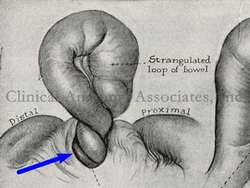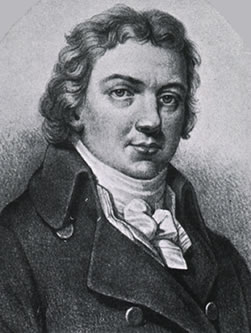
Medical Terminology Daily (MTD) is a blog sponsored by Clinical Anatomy Associates, Inc. as a service to the medical community. We post anatomical, medical or surgical terms, their meaning and usage, as well as biographical notes on anatomists, surgeons, and researchers through the ages. Be warned that some of the images used depict human anatomical specimens.
You are welcome to submit questions and suggestions using our "Contact Us" form. The information on this blog follows the terms on our "Privacy and Security Statement" and cannot be construed as medical guidance or instructions for treatment.
We have 1991 guests online

Georg Eduard Von Rindfleisch
(1836 – 1908)
German pathologist and histologist of Bavarian nobility ancestry. Rindfleisch studied medicine in Würzburg, Berlin, and Heidelberg, earning his MD in 1859 with the thesis “De Vasorum Genesi” (on the generation of vessels) under the tutelage of Rudolf Virchow (1821 - 1902). He then continued as a assistant to Virchow in a newly founded institute in Berlin. He then moved to Breslau in 1861 as an assistant to Rudolf Heidenhain (1834–1897), becoming a professor of pathological anatomy. In 1865 he became full professor in Bonn and in 1874 in Würzburg, where a new pathological institute was built according to his design (completed in 1878), where he worked until his retirement in 1906.
He was the first to describe the inflammatory background of multiple sclerosis in 1863, when he noted that demyelinated lesions have in their center small vessels that are surrounded by a leukocyte inflammatory infiltrate.
After extensive investigations, he suspected an infectious origin of tuberculosis - even before Robert Koch's detection of the tuberculosis bacillus in 1892. Rindfleisch 's special achievement is the description of the morphologically conspicuous macrophages in typhoid inflammation. His distinction between myocardial infarction and myocarditis in 1890 is also of lasting importance.
Associated eponyms
"Rindfleisch's folds": Usually a single semilunar fold of the serous surface of the pericardium around the origin of the aorta. Also known as the plica semilunaris aortæ.
"Rindfleisch's cells": Historical (and obsolete) name for eosinophilic leukocytes.
Personal note: G. Rindfleisch’s book “Traité D' Histologie Pathologique” 2nd edition (1873) is now part of my library. This book was translated from German to French by Dr. Frédéric Gross (1844-1927) , Associate Professor of the Medicine Faculty in Nancy, France. The book is dedicated to Dr. Theodore Billroth (1829-1894), an important surgeon whose pioneering work on subtotal gastrectomies paved the way for today’s robotic bariatric surgery. Dr. Miranda.
Sources:
1. "Stedmans Medical Eponyms" Forbis, P.; Bartolucci, SL; 1998 Williams and Wilkins
2. "Rindfleisch, Georg Eduard von (bayerischer Adel?)" Deutsche Biographie
3. "The pathology of multiple sclerosis and its evolution" Lassmann H. (1999) Philos Trans R Soc Lond B Biol Sci. 354 (1390): 1635–40.
4. “Traité D' Histologie Pathologique” G.E.
Rindfleisch 2nd Ed (1873) Ballieres et Fils. Paris, Translated by F Gross
"Clinical Anatomy Associates, Inc., and the contributors of "Medical Terminology Daily" wish to thank all individuals who donate their bodies and tissues for the advancement of education and research”.
Click here for more information
- Details
This is a medical suffix that originates from the Greek [tomos] which means "to cut" or "to open". The intention is that the opening or wound made will be closed or repaired as soon as practical. Applications of this suffix include:
• Tracheotomy: Opening of the trachea
• Laparotomy: Opening of the abdomen
• Sternotomy: Opening of the sternum
- Details
UPDATED: Cachexia describes a condition where the patient is ill and malnourished. It originates from the Greek word [κακός], meaning "bad". The suffix -ia] denotes "condition". It is a "bad condition" and refers to a bad habitus (body). The term was adopted later in Latin. The term [cachexia] was first used in English in 1541 in a translation of Galen's "Therapeutyke". The adjective form is [cachectic].
The term [cachexia] is used to describe a patient that because of general malnutrition, a chronic disease, or cancer appears very thin, with extreme weight loss, muscular atrophy, and a general appearance of wasting.
Note: The links to Google Translate include an icon that will allow you to hear the Greek or Latin pronunciation of the word.
- Details
UPDATED: The word [volvulus] arises from the Latin word [volvere], meaning "to twist" or "to roll". It refers to the rolling or twisting of a segment of the gastrointestinal (GI) tract enough to cause stenosis or stricture of the vessels supplying the GI segment. This can lead to ischemia and eventual necrosis or infarction of the organ. A volvulus will also cause blockage of the passage of food through the GI tract. The plural for [volvulus] is [volvuli].
A volvulus can occur anywhere the GI tract is intraperitoneal; that is, it has a mesentery or mesentery-like attachment that renders it mobile and therefore can allow it to twist. Most volvuli occur in the transverse and sigmoid colon, as well as the jejunum and ileum. The etiology of a volvulus is multiple, ranging from peristaltic hypermobility, congenital malrotation pathology of the GI tract, to internal hernias, either congenital or acquired.
In the accompanying image by Thorek (1938), the arrow indicates the location of a mesenteric defect, being the cause for an internal hernia and intestinal torsion or volvulus. For more information and images, you can read this 2011 article by Timpone, V.M. et al. on "Abdominal Twists and Turns: Part I, Gastrointestinal Tract Torsions With Pathologic Correlation"
Article image in the public domain. modified from Thorek, 1938 "Modern Surgical Technique"
- Details
This article is part of the series "A Moment in History" where we honor those who have contributed to the growth of medical knowledge in the areas of anatomy, medicine, surgery, and medical research.
Edward Jenner (1749 - 1823). English physician and surgeon, Edward Jenner was born in Berkeley, Gloucestershire. His training included a seven year apprenticeship to a surgeon. He then moved to London where he completed his training at the St. George’s Hospital with John Hunter. Jenner became Hunter’s assistant for anatomical dissection and research. After finishing his studies, he returned to Berkeley.
During Jenner’s time smallpox was a disease with high mortality and terrible complications that could leave a patient blind or scarred for life. Of most interest to him was local lore that related that farmers and milkmaids that contracted cowpox could not contract smallpox, even when in direct exposure to smallpox. Cowpox is a viral infection of cows causing only minor discomfort and complications when acquired by a human.
In 1796 Jenner was visited by Sarah Nelmes, a patient with smallpox-like signs on her hands. Jenner diagnosed cowpox instead of smallpox and discovered that she was a milkmaid. Sensing the need for additional research, he inoculated a young boy by scratching the boy’s skin and then rubbing some of the material exuding from Sarah’s pustules. The boy developed cowpox.
A month and a half later Jenner exposed the boy to smallpox. The boy did not develop any signs or symptoms of smallpox. The new era of vaccination had started.
In spite of his success, the spread of this new technique was slow and not easy, with many detractor and critics. In the end, Jenner was honored for his discovery. In 1980 the World Health Organization formally declared the erradication of smallpox from the world. Individuals are not vaccinated against smallpox anymore and only a few samples of the virus exist in restricted laboratories in the world.
In the pages of “Medical Terminology Daily” we explain why the process is called “vaccination” and also the role that Jenner’s discovery had in the “Royal Philanthropic Vaccination Expedition” to the New World.
Sources:
1. “Edward Jenner and the history of smallpox and vaccination” Riedel, S Proc (Bayl Univ Med Cent). Jan 2005; 18(1): 21–25
2. “Edward Jenner and the eradication of smallpox” Willis NJ Scott Med J. 1997 Aug; 42(4):118-21.
3. "Smallpox; A Great and Terrible Scourge" U.S National Library of Medicine"
Image in the Public Domain. Courtesy of the National Library of Medicine, Digital Collections.
- Details
The medical suffix [-(o)logy] originates from the Greek, although there is discussion as to the real meaning of the term in Ancient Greek. In modern Greek the word [λόγος] (logos) means "reason", while the word [λόγια] (logia) means "words". The fact is that over time the meaning of this suffix has evolved to mean "study of" and has been applied to most of the medical sciences. Some examples are:
- Biology: The study of life
- Histology: The study of tissues
- Anthropology: The study of man
- Physiology: The study of function
- Nephrology: The study of the kidney
- Gynecology: Study of women
Note: The links to Google Translate include an icon that will allow you to hear the Greek or Latin pronunciation of the word.
- Details
The root term [antrhop-] is a derivate from the Greek word [άνθρωπος] (anthropos) meaning "man". [Andr(o)] is a similar root term with the same meaning. Applications of this root term include:
- Anthropoid: The suffix [-oid] originates from the Greek [oeides], meaning "similar to", "like", or "shaped like". Similar to a man
- Anthropogenic: The suffix [-(o)genic] means "pertaining to genesis, creation, or origin”. Something that creates a man
- Anthropologist: The suffix [-(o)logy] means "study of”. The study of man. If you are interested in forensic anthropology, click here for the Facebook page of my good friend Dr. Elizabeth Murray, PhD, DAFBA.
- Anthropometric: The suffix [-(o)metric] means "measurement”. The measurements of man. An example of this are the anthropometric studies of Peter Paul Broca (1824 - 1880) who named many of the craniometric points in the human skull
Note: The links to Google Translate include an icon that will allow you to hear the Greek or Latin pronunciation of the word.



